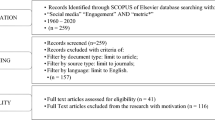Abstract
In computational linguistics, binary sentiment analysis methods have been proposed to predict whether a document expresses a positive or a negative opinion. In this paper, we study a unique research problem—identifying environmental stimuli that contribute to different moods (mood triggers). Our analysis is enabled by an anonymous micro-journalling dataset, containing over 700,000 short journals from over 67,000 writers and their self-reported moods at the time of writing. We first build a multinomial logistic regression model to predict the mood (e.g., happy, sad, tired, productive) associated with a micro-journal. We then examine the model to identify predictive words and word trigrams associated with various moods. Our study offers new data-driven insights into public well-being.

Similar content being viewed by others
Notes
TF-IDF is the frequency of a given word in a given journal divided by the logarithm of the fraction of journals this word appears in.
References
Bagroy S, Kumaraguru P, De Choudhury M (2017) A social media based index of mental well-being in college campuses. In: Proceedings of the 2017 CHI Conference on Human Factors in Computing Systems, pp. 1634–1646. ACM
Bond L, Carlin JB, Thomas L, Rubin K, Patton G (2001) Does bullying cause emotional problems? A prospective study of young teenagers. BMJ 323(7311):480–484
Ekman P (2003) Emotions revealed: recognizing faces and feelings to improve communication and emotional life. Times Books, New York
Ghazi D, Inkpen D, Szpakowicz S (2015) Detecting emotion stimuli in emotion-bearing sentences. In: CICLing, pp 152–165
Go A, Bhayani R, Huang L (2009) Twitter sentiment classification using distant supervision. CS224N Project Report, Stanford 1(12)
Gross JJ, Muñoz RF (1995) Emotion regulation and mental health. Clin Psychol Sci Pract 2(2):151–164
Gui L, Hu J, He Y, Xu R, Lu Q, Du JA (2017) question answering approach for emotion cause extraction. In: EMNLP, pp 1593–1602
James W (1884) What is an emotion? mind. Reprinted in Porges SW , Coles yMGH (eds) Psychophysiology. Hutchinson y Ross 9, Stroudsburg, Pal., Dowden, pp 188–205
Lazarus RS (1991) Progress on a cognitive-motivational-relational theory of emotion. Am Psychol 46(8):819
Lee JA, Efstratiou C, Bai L (2016) Osn mood tracking: exploring the use of online social network activity as an indicator of mood changes. In: Proceedings of the 2016 ACM international joint conference on pervasive and ubiquitous computing: adjunct. ACM, pp 1171–1179
Li W, Xu H (2014) Text-based emotion classification using emotion cause extraction. Expert Syst Appl 41(4):1742–1749
Liebert RM, Morris LW (1967) Cognitive and emotional components of test anxiety: a distinction and some initial data. Psychol Rep 20(3):975–978
Mohammad SM (2012) # emotional tweets. In: Proceedings of the first joint conference on lexical and computational semantics-volume 1: proceedings of the main conference and the shared task, and volume 2: proceedings of the sixth international workshop on semantic evaluation. Association for Computational Linguistics, pp 246–255
Neviarouskaya A, Aono M (2013) Extracting causes of emotions from text. In: Proceedings of the 6th international joint conference on natural language processing, pp 932–936
Nothman J, Qin H, Yurchak R (2018) Stop word lists in free open-source software packages. In: Proceedings of workshop for NLP Open Source Software (NLP-OSS), pp 7–12
Pang B, Lee L (2005) Seeing stars: exploiting class relationships for sentiment categorization with respect to rating scales. In: Proceedings of the 43rd annual meeting on association for computational linguistics. Association for Computational Linguistics, pp 115–124
Pang B, Lee L, Vaithyanathan S (2002) Thumbs up?: sentiment classification using machine learning techniques. In: Proceedings of the ACL-02 conference on Empirical methods in natural language processing, vol 10. Association for Computational Linguistics, pp 79–86
Park A, Conway M, Chen AT (2018) Examining thematic similarity, difference, and membership in three online mental health communities from reddit: a text mining and visualization approach. Comput Hum Behav 78:98–112
Project PI (2019) Social media fact sheet. In: International conference on learning representations. https://www.pewinternet.org/fact-sheet/social-media/
Socher R, Perelygin A, Wu J, Chuang J, Manning CD, Ng A, Potts C (2013) Recursive deep models for semantic compositionality over a sentiment treebank. In: Proceedings of the 2013 conference on empirical methods in natural language processing, pp 1631–1642
Sudhof M, Goméz Emilsson A, Maas AL, Potts C (2014) Sentiment expression conditioned by affective transitions and social forces. In: Proceedings of the 20th ACM SIGKDD international conference on Knowledge discovery and data mining. ACM, pp 1136–1145
Taboada M, Brooke J, Tofiloski M, Voll K, Stede M (2011) Lexicon-based methods for sentiment analysis. Comput Linguist 37(2):267–307
Thelwall M, Buckley K, Paltoglou G, Cai D, Kappas A (2010) Sentiment strength detection in short informal text. J Am Soc Inf Sci Technol 61(12):2544–2558
Wang W, Chen L, Thirunarayan K, Sheth AP (2012) Harnessing twitter “big data” for automatic emotion identification. In: 2012 International conference on privacy, security, risk and trust and 2012 international conference on social computing. IEEE, pp 587–592
Zhang X, Zhao J, LeCun Y (2015) Character-level convolutional networks for text classification. In: Advances in neural information processing systems, pp 649–657
Author information
Authors and Affiliations
Corresponding author
Additional information
Publisher's Note
Springer Nature remains neutral with regard to jurisdictional claims in published maps and institutional affiliations.
Rights and permissions
About this article
Cite this article
Chen, L., Golab, L. Micro-journal mining to understand mood triggers. Computing 102, 1227–1244 (2020). https://doi.org/10.1007/s00607-019-00777-6
Received:
Accepted:
Published:
Issue Date:
DOI: https://doi.org/10.1007/s00607-019-00777-6




